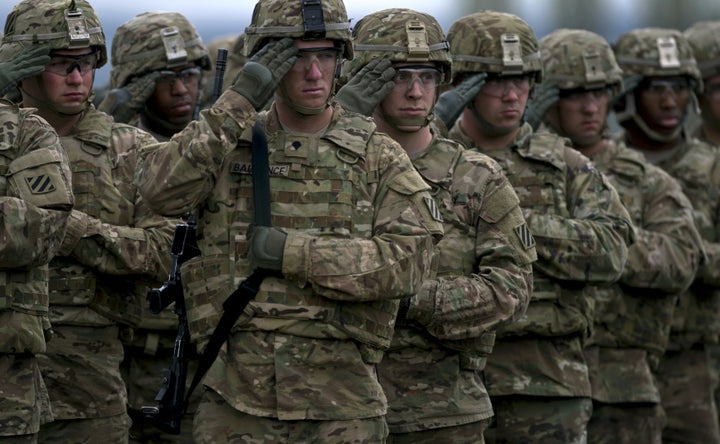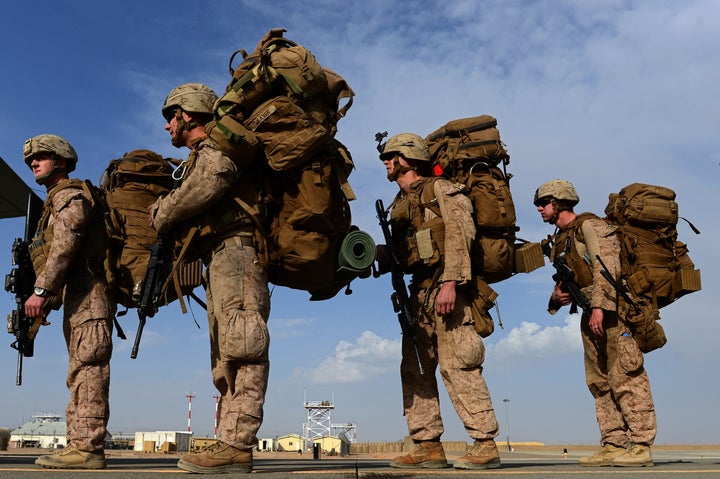CAMP LEJEUNE, N.C. ― The USS Gerald R. Ford, the new aircraft carrier President Donald Trump praised recently, is costing some $13 billion to build. That doesn’t count the airplanes. It’s the most expensive naval vessel in history, and it will fit easily into the “massive” military buildup Trump has demanded.
But at Camp Lejeune, the sprawling Marine Corps base where the working-class military lives, trains and deploys, there’s not enough money for Cpl. Edward L. Kiser, an anti-tank gunner, to train properly. Kiser, a 20-year-old from Butler, Pennsylvania, needs to be proficient at firing TOW missiles in the desperate heat of battle to kill enemy tanks about to overrun his position. “I’ve been in the Marine Corps two years, and I’ve only shot the thing one time,” said Kiser.
The U.S. soldiers and Marines confronting the Islamic State in Iraq and Syria are facing so-called “rag-tag” fighters equipped with tiny surveillance and attack drones, which let those forces hunt down Americans and kill them from the sky.
Americans have neither. Again, no money for that.
Trump, who positions himself as the champion of the working class, has promised to pump billions more into the military. Yet the initial numbers suggest those who really benefit will be the ones who always benefit: the big defense contractors and their enablers at the Pentagon and Congress. The last people to see that flood of spending will be the ones most likely to fight and die: the grunts.

Only the outlines of Trump’s proposal to lavish money on the military have been drawn up. There’s a request for Congress to add $30 billion to this year’s defense budget and a vague plan to add $54 billion to next year’s spending.
Not included in those plans: money for the best infantry weapons, the safest troop-lift helicopters, the most protective lightweight body armor. Instead, grunts will have to settle for budget leftovers with antiquated rifles, helicopters built for their grandfathers during the Vietnam War and communications gear that is overweight and unreliable.
Much of the money will be hoovered up for gold-plated weapon systems like the USS Ford, F-35 fighters ($95 million each), nuclear weapons ($40 billion a year) and Columbia-class ballistic missile submarines ($5 billion apiece). None of these weapon systems get nearly as much direct combat exposure ― if any ― as the soldiers and Marines under fire today in Iraq, Afghanistan and Syria. But the stuff they need just isn’t as dramatic as an F-35 fighter, doesn’t provide the thousands of home-district jobs that politicians love and fails to offer the high profits that drive defense contractors.
In the request that Trump just sent up to Capitol Hill, for instance, he asked for $5.8 billion extra for Navy and Air Force fighter jets, but only $750 million more for Army weapons and heavy combat vehicles. Military personnel accounts are slated for just $977 million more, mostly for a 2.1 percent pay increase signed into law by President Barack Obama in December. Accounts that cover new family housing got nothing.
None of this is particularly new. “Four out of five of those killed in our wars are infantry, but they get 1 percent of our national resources,” said Robert H. Scales, a combat-decorated Army major general now retired.
“Either I don’t have them, or I do have them and they’re broken. So when we go to train, the optic falls off when you shoot.”
- Marine Lt. Caleb Rich, referring to sights for grenade launchers
Marines at Camp Lejeune are proud of their warfighting capabilities. But when pressed, they’ll talk about weapons that don’t work, trucks that are broken down, combat exercises canceled for lack of money.
Lt. Caleb Rich, executive officer of Echo Company, 2nd Battalion, 8th Marine Regiment, is responsible for ensuring all the Marines in his company meet training requirements. “I can’t achieve all the tasks I have to do with the ammo I’ve been given,” he said. “One training event will eat up 90 percent of my ammo.”
The optical sights for his M203 grenade launchers, needed for accuracy against distant targets, are another problem. “Either I don’t have them, or I do have them and they’re broken,” said Rich, a 30-year-old from Columbus, Ohio. “So when we go to train, the optic falls off when you shoot.”
Night vision goggles (NVGs), which enable grunts to outfight the enemy at night? “The ones I have don’t work or they’re outdated, and that limits me on night training,” Rich said. “We like to say we own the night. Well, we don’t own the night if we don’t have NVGs.”
The equipment that fighting men and women need “is not all that glamorous,” said Paul Scharre, director of the Future of Warfare Initiative at the Center for a New American Security. Consider boots.
Scharre is a former Army Ranger who served multiple tours on special operations missions in Iraq and Afghanistan. When he got to the Ranger Regiment in 2001, he said he was handed a pair of Vietnam-era jungle boots made 40 years earlier. “It was crazy ― we walk around a lot,” he said.
But there is no line item in the defense budget for boots, so these inexpensive yet critical items are often overlooked. “It’s the big-ticket items that get priority by the services, the Pentagon leadership and Congress,” Scharre said.

This disheartening disparity between the defense upper class and its working class is starkly clear in the case of the USS Ford.
Retired Navy Adm. Thomas Fargo is chairman of the board of Huntington Ingalls Industries, which is building that aircraft carrier through its Newport News Shipbuilding subsidiary in Virginia. Fargo earns some $450,000 a year in pay and stock awards, according to the most recent corporate proxy statement.
On his watch, the USS Ford has gone three years over schedule and more than $1 billion over promised cost. Its arresting gear alone ― which stops the planes when they land on the deck ― has been in development for 10 years and is half a billion dollars over budget. The ship’s multiple technical glitches and malfunctions mean there is “significant risk to [its] use in combat,” according to the most recent Pentagon assessment.
In contrast, a typical grunt sergeant, married with two children, pulls down $34,279.20 in base pay. He or she may be a squad leader, responsible for the lives of 12 soldiers or Marines, their training and their gear. Housing and other allowances can bring the sergeant’s pay up to $57,634.68.
Needless to say, a Marine sergeant responsible for a program wildly over budget and schedule would be hauled before an angry commander ― not receiving his pay and bonuses. Fargo, through a spokesperson, declined to be interviewed.
“You have to have money first.”
- Marine Lt. Col. Noah Spataro
An immediate, lifesaving issue that could also be resolved with more money: the provision of small personal infantry drones. In the 16 years of fighting in Afghanistan, 84 percent of Americans killed have lost their lives while simply trying to find the enemy ― and then suddenly running into him, according to Scales.
Tiny surveillance drones could pinpoint the enemy before the first shot is fired. For under $40, a grunt could have his or her own spy drone today. They could (if authorized) buy them in stores, like ISIS does. If they’d had the money to do that years ago, they might have found the enemy before walking into an ambush or driving over an explosive device, and some of those lost lives could have been saved.
The Marine Corps, after years of experimenting with small drones, is now scrambling to get them into the hands of its fighting forces. By this summer, 11 battalions that are deployed or scheduled to deploy will have access to InstantEye or PD-100 “Black Hornet” drones.
Of course, these are more sophisticated and battle-ready devices than those available at Walmart, hardened against dust and rain and encrypted against cyberattack. As Lt. Col. Noah Spataro, who oversees the Marine drone program, explained, it would be no good if a Marine carried a Walmart drone all the way to Iraq only to find it broke in transit.
But the Marines have been experimenting with these drones since 2013. Why couldn’t the corps move faster and get a drone to every 12-man Marine squad?
“You have to have money first,” Spataro said.
Grunts might like more money for personal gear from a Trump budget. For instance, the Pentagon has spent billions on miniaturizing the components in high-tech aircraft like the F-22 and F-35, whose pilots ride in air-conditioned cockpits. But the infantry carry an increasingly heavy combat load that could be significantly eased by more lightweight gear and by having drones resupply food, water and ammo so the grunts don’t have to haul multiple days’ worth of supplies. “We have the most overburdened force in history,” said Scharre. “I was on a mission where I was carrying 160 pounds!”
Marines and soldiers also go into battle with a rifle designed in the 1960s, the venerable M16, and its newer modification, the M4. Some swear by their reliability and accuracy, but there are newer weapons that are far more accurate and can even fire around corners. The TrackingPoint infantry weapont infantry weapon, for instance, has an optical tracking and fire-control system that enables anyone to hit a target to within half an inch at a distance of half a mile. The XM-25 grenade launcher locates a person hiding behind a wall or around a corner, and then directs a grenade just past the corner or wall before it detonates with deadly shrapnel.
The Army has been struggling since 1994 to find a replacement for the M16 family of rifles, but the effort has crashed and burned because of bureaucratic fumbling and lack of sustained funding.
While taxpayers are shelling out for the USS Ford and its corporate overseers, Lt. Col. Randall K. Jones commands a logistics battalion at Camp Lejeune. “Readiness is in the toilet,” he said. “I have four wreckers and they’re all down because we don’t have the mechanics or the spare parts. So, reality check.”
Stuff that breaks down or is simply missing, weapons that are inferior to the enemy’s, money that’s siphoned off to executives in plush offices: it’s all just one more thing that generations of grunts have had to overcome.
That attitude “is what makes the Marine Corps one of the best services,” Lt. Rich said. “We are not completely reliant on gear. If our GPS fails, we use compass and map. If my antenna breaks, I know how to make a field-expedient antenna.”
Still, he added wistfully, “It’d be better if I had all my equipment …”

